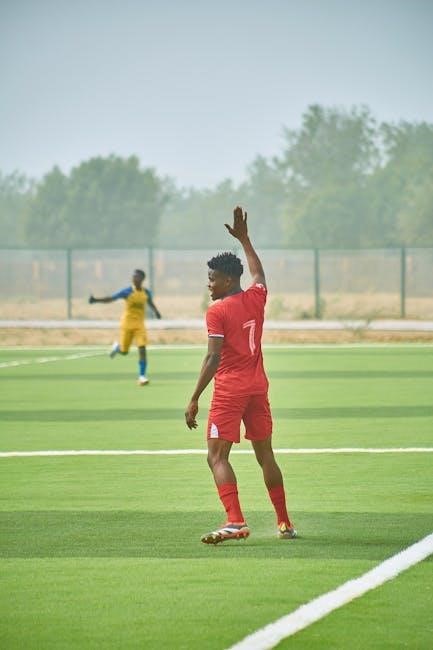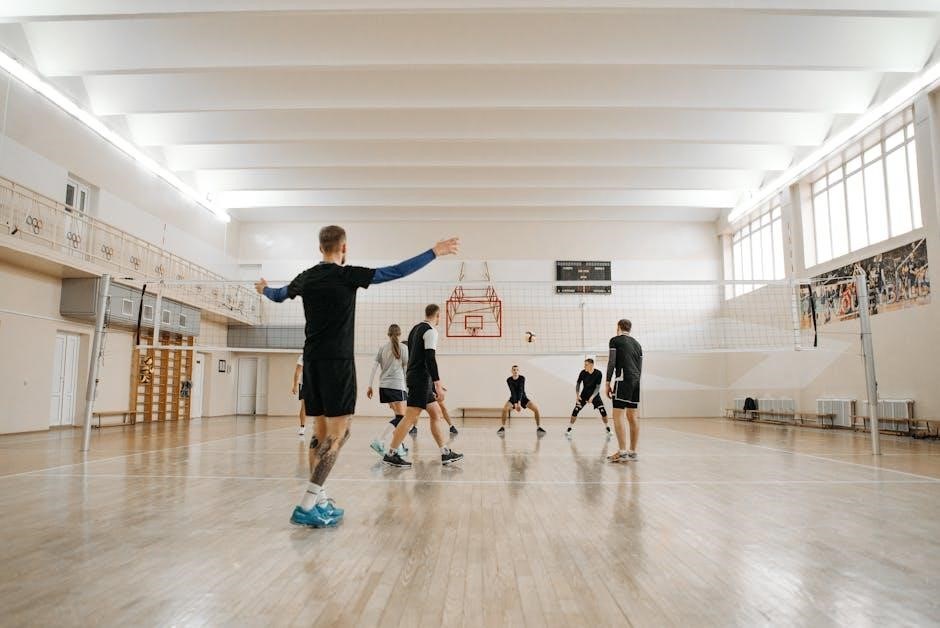The 7 Habits of Highly Effective Teams: A Comprehensive Guide

This guide explores the framework for coaching teams, derived from “The 7 Habits of Highly Effective People.” It focuses on fostering personal growth, collaboration, and team success. Integrating principles into practical activities inspires transformative habits. It’s a pathway to enduring team performance and effectiveness.
Stephen Covey’s “The 7 Habits of Highly Effective People” provides a principle-centered approach to personal and professional effectiveness. The framework offers a holistic, integrated guide for solving personal and professional problems. It’s not just a collection of techniques, but a foundation for strengthening character and building lasting success. This framework is applicable to individuals, teams, and organizations.
The 7 Habits emphasize collaboration, communication, and a shared purpose, essential elements of teamwork. This framework differentiates high performance from mediocrity. It is designed to foster personal growth and sustained success. The principles are proven to shift paradigms of life and work. Teams can use the habits to achieve greater insights.
This guide brings Covey’s principles to life. It provides practical guidance for teams looking to enhance their effectiveness. The 7 Habits are not about quick fixes. They are about building a solid foundation of effectiveness. This framework helps teams achieve high performance through repeatable and proven principles. It encourages individuals to work well with others. It also fosters a positive and collaborative team environment.

Habit 1: Be Proactive ౼ Taking Initiative in Teams
Being proactive, the first habit, centers on taking initiative and responsibility within a team setting. It means not waiting for instructions but actively seeking opportunities to contribute and improve processes. Proactive teams don’t blame external circumstances. They focus on what they can control. This habit empowers team members to overcome challenges and drive positive change.
Proactive teams anticipate problems and develop solutions. They take ownership of their tasks and outcomes. Individuals demonstrate initiative by identifying areas where they can add value. Team members actively seek feedback and continuously improve their skills. Proactive behavior fosters a culture of accountability and empowerment.

This habit encourages team members to make a positive difference. It promotes a commitment to continuous learning and growth. Proactive teams are more resilient. They adapt to change more effectively. They are driven by a desire to achieve team goals. Proactivity involves thoughtful decision-making and responsible action. It is essential for high-performance teams.
Embracing proactivity transforms teams into dynamic, forward-thinking units. It enhances collaboration and creates an environment of ownership. The habit sets the stage for implementing other effective habits.
Habit 2: Begin with the End in Mind ― Defining Team Goals
Beginning with the end in mind is about clearly defining the team’s goals and vision. It ensures that everyone understands the desired outcome and works towards a common purpose. This habit involves creating a shared understanding of success. It also aligning individual efforts with the overall team objectives.
Effective teams start by visualizing their goals. They then break them down into actionable steps. This process involves collaboration and communication. It ensures everyone is on the same page. The team must have a clear understanding of their mission.
Having defined goals provides direction and motivation. It enables team members to prioritize tasks. It helps make informed decisions. This habit promotes focus and reduces wasted effort. It ensures that the team’s energy is directed towards the most important objectives.
Defining team goals involves setting SMART objectives. These are Specific, Measurable, Achievable, Relevant, and Time-bound. Regular reviews and adjustments may be needed. This ensures the team remains on track. It also allows for adaptability.
When team goals are well-defined and understood, individuals can see how their contributions make a difference. This leads to increased engagement and commitment. Beginning with the end in mind provides a strong foundation for team success.
Habit 3: Put First Things First ― Prioritizing Team Tasks
Putting first things first involves prioritizing team tasks based on importance and urgency. This habit emphasizes the ability to manage time effectively. It helps ensure that the most critical tasks are addressed promptly. It also helps prevent less important tasks from overshadowing vital objectives.
Effective teams identify their priorities by assessing the impact of each task on the team’s goals. They differentiate between urgent and important tasks. They avoid getting caught up in the “urgency addiction.” They focus on activities that contribute to long-term success.
Prioritizing involves creating a clear schedule. The schedule should allocate time for essential tasks. It also includes setting deadlines and sticking to them. Teams can use tools like task management software. These tools help them track progress and maintain focus.
Delegation is a crucial aspect of putting first things first. It involves assigning tasks to team members based on their skills and availability. This frees up time for leaders to focus on high-level priorities. It also promotes team member growth and development.
Teams that prioritize effectively experience reduced stress and increased productivity. They are better equipped to handle unexpected challenges. They can adapt to changing priorities. Putting first things first fosters a culture of discipline and accountability. It ensures that the team consistently delivers results.
Habit 4: Think Win-Win ౼ Fostering Collaboration
Thinking win-win is about fostering collaboration; It is about finding solutions that benefit all parties involved. This habit promotes trust, mutual respect, and understanding within the team. It’s essential for creating a positive and productive work environment.
Effective teams recognize that collaboration is more powerful than competition. They actively seek to understand the needs and perspectives of their colleagues. They work together to find solutions that meet everyone’s needs. This involves open communication, active listening, and a willingness to compromise.
Win-win thinking requires an abundance mentality. This is the belief that there are enough resources and opportunities for everyone to succeed. Teams with this mindset are more likely to collaborate effectively and share knowledge. They will also support each other’s growth.
Conflicts are inevitable in any team. A win-win approach can help resolve conflicts constructively. It does this by focusing on finding solutions that address the underlying needs of all parties. This involves active listening, empathy, and a commitment to finding common ground.

Teams that embrace win-win thinking experience increased morale and engagement; They are more likely to achieve their goals. They develop strong, lasting relationships. This habit fosters a culture of trust and collaboration. This results in greater innovation and success.
Habit 5: Seek First to Understand, Then to Be Understood ― Effective Communication
Effective communication hinges on understanding before seeking to be understood. This principle emphasizes empathetic listening. The ability to truly grasp another’s perspective before expressing your own is vital. This will foster deeper connections within the team.
Teams that prioritize understanding over being understood create a safe space. It is a space where members feel valued and heard. This cultivates trust and encourages open dialogue. It also reduces the likelihood of misunderstandings and conflicts.
Active listening is a cornerstone of this habit. It involves paying attention not only to the words being spoken, but also the emotions and intentions behind them. It requires asking clarifying questions and summarizing to ensure accurate comprehension.
Once you have truly understood another’s perspective, you can then effectively communicate your own. This involves tailoring your message to resonate with the other person. It also involves using clear, concise language and providing relevant context.

This habit promotes collaboration and problem-solving. It empowers team members to work together effectively. It fosters innovation and strengthens relationships. Seeking first to understand transforms communication from a monologue into a meaningful dialogue. This drives team success and cohesion.
Habit 6: Synergize ― Teamwork and Creative Cooperation
Synergy embodies the essence of teamwork and creative cooperation. It’s about combining strengths to achieve something greater than the sum of individual efforts. This habit encourages team members to value differences and seek solutions that benefit everyone involved.
Effective teams embrace diverse perspectives and leverage individual talents. They recognize that different viewpoints can lead to innovative solutions. It’s through open communication and mutual respect that synergy truly flourishes.

Teams that synergize create an environment where members feel comfortable sharing ideas. They also feel comfortable challenging assumptions. This fosters a culture of creativity and continuous improvement. Collaboration becomes a natural way of working.
Synergy requires a win-win mentality. Team members focus on finding solutions that meet the needs of all parties involved. This promotes trust and builds strong relationships.
To synergize effectively, teams must practice empathy and active listening. They should also be willing to compromise and find common ground. This requires a willingness to step outside one’s own perspective and consider the needs of others.
The result of synergy is a team that is more productive, innovative, and resilient. This promotes a sense of shared purpose and accomplishment. This enables the team to achieve remarkable results.
Habit 7: Sharpen the Saw ― Continuous Improvement and Team Wellbeing
“Sharpen the Saw” emphasizes the importance of continuous improvement and team wellbeing. It encourages teams to renew themselves physically, mentally, socially/emotionally, and spiritually. This ensures long-term effectiveness and prevents burnout.
Effective teams prioritize activities that revitalize their members. This includes taking breaks, pursuing personal interests, and engaging in team-building activities. These promote physical and mental health.

Continuous learning is also crucial. Teams should seek opportunities to expand their knowledge and skills. This can involve attending workshops, reading industry publications, or simply sharing insights with one another.
Social and emotional wellbeing is another key aspect. Teams should foster a supportive and inclusive environment; They should also encourage open communication and address conflicts constructively.
Spiritual renewal involves connecting with values and purpose. Teams should reflect on their mission and goals. They should also ensure that their work aligns with their personal values.
By investing in these areas, teams can enhance their resilience and adaptability. They will also be better equipped to handle challenges and achieve their goals.
“Sharpening the Saw” is not a one-time activity. It’s an ongoing process. Teams should regularly assess their needs and adjust their strategies accordingly. This ensures that they remain effective and sustainable over time.
Applying the 7 Habits in Remote and Mixed Teams
Applying the 7 Habits in remote and mixed teams requires intentional adaptation. Communication becomes paramount, demanding proactive efforts to ensure clarity and prevent misunderstandings. Utilizing technology effectively, such as video conferencing and collaborative platforms, is crucial.
Building trust in a virtual environment necessitates consistent reliability and open dialogue. Scheduling regular virtual team-building activities can foster camaraderie and strengthen relationships. Establishing clear roles and responsibilities minimizes confusion and promotes accountability.
Prioritizing tasks and managing time effectively is essential for remote workers; Encouraging self-care and promoting work-life balance helps prevent burnout. Leaders must be mindful of diverse work styles and communication preferences, adapting their approach accordingly.

Creating a shared understanding of team goals is vital, requiring frequent check-ins and progress updates. Celebrating successes and recognizing individual contributions boosts morale and reinforces positive behaviors.
Addressing conflicts promptly and constructively is crucial, utilizing virtual mediation when necessary. Cultivating a culture of empathy and understanding helps bridge communication gaps and foster collaboration.
By actively addressing these challenges, remote and mixed teams can successfully apply the 7 Habits, achieving high levels of effectiveness and team cohesion, irrespective of physical location.
Ultimately, it’s about fostering a sense of connection and shared purpose, transcending geographical boundaries and creating a truly collaborative team environment.
Common Pitfalls and How to Avoid Them
Several pitfalls can hinder a team’s effectiveness when implementing the 7 Habits. A common issue is superficial adoption, where teams understand the concepts but fail to internalize and consistently apply them. To avoid this, ensure thorough training and ongoing reinforcement through practical exercises and real-world application.
Another pitfall is neglecting individual needs and differences. Teams must recognize diverse work styles, communication preferences, and personal challenges. Foster an inclusive environment where every member feels valued and supported, encouraging open communication and empathy.
Lack of clear goals and accountability can derail progress. Define specific, measurable, achievable, relevant, and time-bound (SMART) goals. Establish clear roles and responsibilities, ensuring everyone understands their contributions and is held accountable for their performance.
Resistance to change is a natural human reaction. Address resistance by explaining the benefits of the 7 Habits, involving team members in the implementation process, and celebrating early successes to build momentum. Effective leadership is crucial in guiding the team through the transition.

Communication breakdowns can cripple teamwork. Establish clear communication channels, encourage active listening, and promote open and honest dialogue. Regularly solicit feedback and address concerns promptly to prevent misunderstandings and conflicts.
By proactively addressing these potential pitfalls, teams can maximize the benefits of the 7 Habits and achieve sustained high performance.
Building a Foundation for Enduring Team Success
By fostering proactive attitudes, defining clear goals, prioritizing tasks, thinking win-win, seeking understanding, synergizing efforts, and continuously improving, teams can achieve remarkable results. The principles underlying these habits are timeless and universally applicable, transcending industries and organizational structures.
The true power of the 7 Habits lies in their ability to unlock the potential within each team member and harness the collective intelligence of the group. Effective teams are not merely collections of individuals but cohesive units working towards a common purpose.
Implementing the 7 Habits requires commitment from both leadership and team members. It necessitates a willingness to challenge existing paradigms, embrace change, and prioritize long-term success over short-term gains. With dedication and perseverance, teams can build a foundation for enduring success, achieving not only their goals but also fostering a positive and fulfilling work environment.
Ultimately, the 7 Habits offer a pathway to creating teams that are not only highly effective but also resilient, adaptable, and capable of thriving in an ever-changing world.





